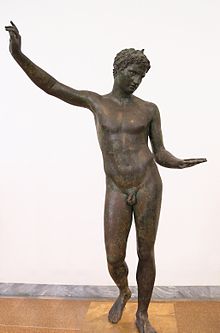Marathon Boy
| Marathon Boy | |
|---|---|
 | |
| Material | Bronze |
| Height | 1.3 meters |
| Created | 340 – 330 BC |
| Discovered | June 1925 Aegean Sea |
| Present location | Athens, Attica, Greece |
The Marathon Boy or Ephebe of Marathon is a Greek bronze sculpture found in the Aegean Sea in the bay of Marathon in 1925.
The sculpture is conserved in the
National Archaeological Museum of Athens where it is dated to around 340–330 BC.[1] The Museum suggests that the subject is the winner of an athletic competition. With its soft musculature and exaggerated contrapposto, its style is associated with the school of Praxiteles. The upraised arm and the distribution of weight indicate that in his original context, this ephebe was leaning against a vertical support, such as a column.[2]
Other underwater finds
Before the advent of
Getty Victorious Youth dredged up off the coast of Fano, Italy; the Riace bronzes, found in 1972; the Dancing Satyr of Mazara del Vallo, in the Sicily Channel, 2003; and the Apoxyomenos recovered from the sea off the Croatian island of Lošinj
in 1999.
Notes and references
- ^ X 15118. National Archaeological Museum, Athens, 2013. Retrieved 29 May 2013. Archived here.
- ^ The unusual stance was noted by Gisela Richter, "The Hermes of Praxiteles" American Journal of Archaeology 35.3 (July - September 1931:277-290) p. 280, crediting W. Wrede, in Arch. Anz. 1926:401 with the observation. On this, see also Dafas, K. A., 2019. Greek Large-Scale Bronze Statuary: The Late Archaic and Classical Periods, Institute of Classical Studies, School of Advanced Study, University of London, Bulletin of the Institute of Classical Studies, Monograph, BICS Supplement 138 (London), pp. 84-96, pls 72-81.
External links
![]() Media related to Marathon Boy, NAMA X15118 at Wikimedia Commons
Media related to Marathon Boy, NAMA X15118 at Wikimedia Commons
- "The Marathon Boy and the Satyr" Comparable Roman marbles of a Satyr pouring wine.

